Chapter 10
Pay for Play: Making Mobile Payments with Apple Watch
IN THIS CHAPTER
![]() Understanding Apple Pay
Understanding Apple Pay
![]() Using Apple Pay on Apple Watch
Using Apple Pay on Apple Watch
![]() Setting up Apple Watch for Apple Pay
Setting up Apple Watch for Apple Pay
![]() Paying with Apple Watch without a nearby iPhone
Paying with Apple Watch without a nearby iPhone
![]() Accessing Wallet on Apple Watch (including passes)
Accessing Wallet on Apple Watch (including passes)
![]() Using Apple Cash and Apple Cash Family on Apple Watch
Using Apple Cash and Apple Cash Family on Apple Watch
![]() Using Apple Watch for deals and rewards
Using Apple Watch for deals and rewards
This chapter looks at how to use Apple Pay on Apple Watch, as well as Apple Pay Cash, to send friends money. First, though, a brief primer on what Apple Pay is.
If you own an iPhone 6 or newer, then perhaps you’ve had a chance to try out Apple Pay (www.apple.com/apple-pay), Apple’s proprietary mobile payment solution that lets you buy goods and services without needing your wallet.
Simply wave your compatible phone over a contactless terminal at a participating retailer — with your finger on the Touch ID sensor (built into the Home button) or with newer models, looking at your iPhone’s camera using Face ID technology — and the transaction is completed. This saves time at retail because you don’t have to dig for the exact change or deal with finding the right credit or debit card in your wallet.
Intrigued? Read on to find out how to set up and use Apple Pay, how to use Apple Pay Cash, how to send cash to friends, and how to access Apple Watch-specific deals and rewards.
Apple Watch and Security
Before I talk about paying for something on Apple Watch, a word on Apple Pay on iPhone.
If you’re worried about security, Apple Pay (shown in Figure 10-1) doesn’t disclose your financial information to the retailer; it uses a unique numerical token rather than actual credit or debit card numbers shared with the store (which could put your info at risk). In fact, Apple claims using Apple Pay is safer than using a physical card.
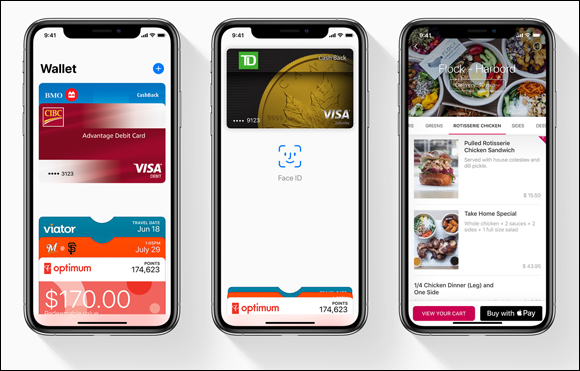
FIGURE 10-1: Leave your wallet at home and use the Wallet app instead! Simply tap your iPhone or Apple Watch at retail to buy something securely.
Because of the integrated near field communication (NFC) antenna in the latest iPhones, you don’t need to open an app or even wake up your phone to use it. As long as your one-of-a-kind fingerprint or face is detected — two examples of biometrics technology that prove it’s you and only you — you should feel a subtle vibration on the iPhone, and hear a small beep to confirm the digital handshake has been made.
You can also use Apple Pay to pay for apps in the online App Store. For this, you can also use the Touch ID or Face ID sensor built into iPhones, iPads, and MacBook Pro (but you can’t use the tablet or computer to pay at retail). Checking out is as easy as selecting Apple Pay from the list of options and using your finger or face to identify you.
Before you can use Apple Pay — on any device — you first need to establish your Apple Pay account. You do this first on iPhone and then Apple Watch.
Setting Up Apple Pay on iPhone
 Setting up your iPhone for Apple Pay involves your Wallet app (formerly Passbook), which stores such things as boarding passes, movie tickets, store coupons, loyalty cards, and more. It can store your credit and debit card information too.
Setting up your iPhone for Apple Pay involves your Wallet app (formerly Passbook), which stores such things as boarding passes, movie tickets, store coupons, loyalty cards, and more. It can store your credit and debit card information too.
I get to setting up Apple Pay on Apple Watch shortly, after covering the other Apple devices first. To set up Apple Pay on your iPhone, follow these steps:
-
Tap the Wallet app icon on your iPhone.
The Wallet app launches. The first time you open it, you’re prompted to allow Wallet to use your location. Select what you’re comfortable with. I would recommend selecting “Allow While Using App.”
-
Tap the + sign in the upper-right corner, as shown in Figure 10-2.
This lets you add a new card.
-
Use your device’s main (rear-facing) camera to capture the information on your credit and debit card or choose to enter it in manually.
You have to fill in additional information it might ask for, such as the security code.
-
Your bank then verifies your information and decides if you can add your card to Apple Pay.
Not all banks are supported, but many are. You may be prompted to provide additional information to verify it’s you for your own security and privacy.
-
Tap Next after your card is verified.
You can now start using Apple Pay at supported retailers and in the App Store. Keep in mind that the first card you add is your default payment card, but you can go to the Wallet app anytime to pay with a different card (or select a new default in Settings ⇒ Wallet & Apple Pay). Otherwise, you don’t need to do anything. See the “Looking at the Wallet App” section later in this chapter for more on changing your default card and other options.

FIGURE 10-2: It’s a breeze to set up your iPhone with Apple Pay. The step-by-step instructions should take you less than three minutes (seriously).
What happens if you lose your iPhone, iPad, or Apple Watch? Don’t worry about them being used to make a fraudulent purchase. The crook will need your unique finger on the Touch ID sensor (Home button), your face for Face ID, or a PIN for Apple Watch. If you ever misplace your phone or tablet, you can use the Find My iPhone feature on the iCloud website (www.icloud.com) or on another iOS device to quickly put your device in Lost Mode to suspend Apple Pay. Alternatively, you can completely wipe your device clean of any data. And yes, you can now find your Apple Watch using the Find My app on iOS devices (and iCloud.com). So long as your Apple Watch has power, it will show up on the Find My map on an iPhone or iPad.
Setting Up Apple Pay on Apple Watch
As shown in Figure 10-3, the process to set up Apple Pay on Apple Watch is similar to the other Apple products:
-
Open the Apple Watch app on your iPhone, and tap the My Watch tab (lower-left corner).
If you have multiple watches, choose one (for me it says “Marc’s Apple Watch, 44mm”).
- Tap Wallet & Apple Pay near the bottom of the screen.
- Tap the orange words Add Card, and follow the steps to add a card.
-
To add a new card, tap Add Credit or Debit Card.
If you’re asked to add the card that you use with iTunes, cards on other devices, or cards that you’ve recently removed, choose them, and then enter the card security codes. Note: Apple Pay requires a passcode on Apple Watch. If you don’t have one set up, you can tap the orange “Set Up Passcode” and follow the prompts.
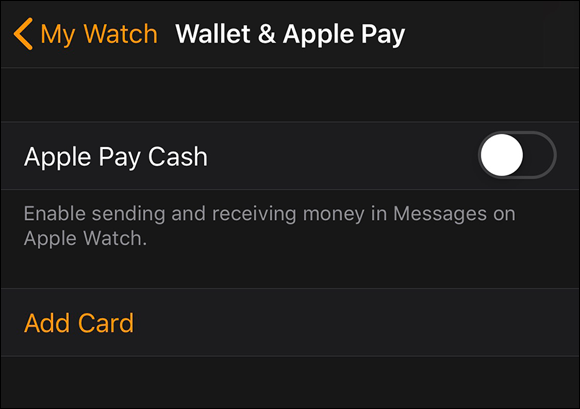
FIGURE 10-3: You only need to activate a credit or debit card once on your Apple Watch, then you’re good to go.
-
Tap Next.
Your bank or card issuer will verify your information and decide if you can use your card with Apple Pay. If your bank or issuer needs more information to verify your card, you’re prompted for it. When you have the info, go back to Wallet & Apple Pay and tap your card.
-
After your bank or issuer verifies your card, tap Next.
You can now start using Apple Pay (see the next section).
Using Apple Pay with Your Apple Watch
Because you’re wearing Apple Watch as opposed to holding it, Apple Pay on Apple Watch is even easier and faster to use at retail than an iPhone. Simply wave your Apple Watch over a contactless terminal at a supporting retailer.
Those wearing an Apple Watch can keep their phones tucked away in a purse or pocket — or even left at home if preferred — but the payment process is similar.
To pay for something with your Apple Watch, follow these steps:
-
Step up to a contactless reader (point-of-sale terminal).
Yes, these are the same ones that support smartphones and NFC-enabled cards, such as Visa’s PayWave, MasterCard’s PayPass, and Amex’s ExpressPay. The person behind you might not be sure what you’re doing. Just smile and proceed to the next step.
-
Double-tap the side button on Apple Watch.
You’re now ready to make the digital handshake.
-
Hold the face up to the contactless reader, and within a second or two, a tone and slight vibration confirms your payment information has been successfully sent.
You won’t need to open an Apple Pay app on the watch or anything like that. No wonder Apple calls it “Your wallet. Without a wallet.”
-
If you need to choose Credit or Debit on the terminal, choose Credit.
Depending on the store and transaction amount, you might need to sign a receipt or enter your PIN.
You will, though, have to open the Wallet app on Apple Watch if you want to switch cards while paying. To do that, follow these steps:
-
Double-tap the side button to display Wallet.
You can also say “Hey Siri, Wallet” or press the Digital Crown button and find and tap the Wallet app. This is a similar process to paying using Apple Pay, but don’t hold your watch up to the contactless reader just yet.
- Swipe up or down with your fingertip or twist the Digital Crown button to browse through your cards.
- Select the card you want.
-
Hold the Apple Watch face near the NFC reader to pay. See Figure 10-4.
You should feel a slight vibration and hear a faint chime to confirm the transaction was successfully completed.
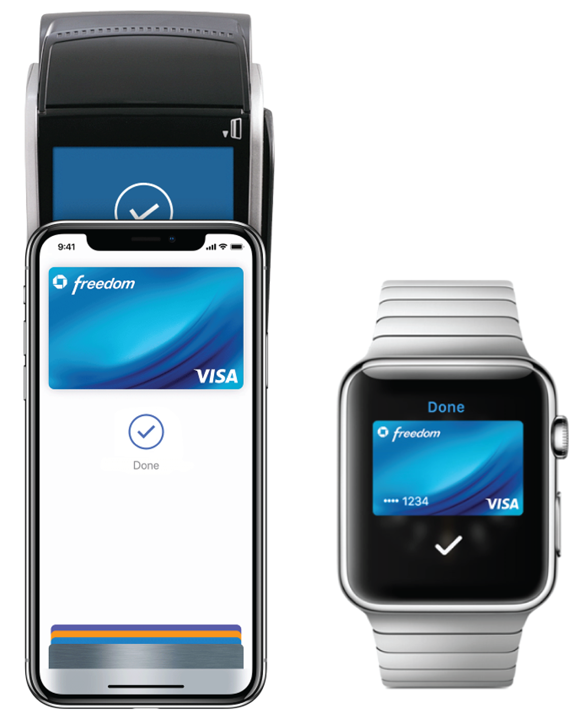
FIGURE 10-4: At a contactless reader, tap your iPhone or Apple Watch to use Apple Pay (left). On Apple Pay for Apple Watch, press the side button twice and tap to pay (right).
Paying without a Nearby iPhone
Remember, Apple Pay differs from most other mobile payment solutions because your credit or debit card number is never visible to the retailer and is thus safer to use. When you add your card information to Apple Watch, that unique and encrypted Device Account Number (DAN) is assigned and stored on a dedicated chip inside the watch (that Secure Element technology, like with the newer iPhones and iPads).
“But wait a sec,” you’re thinking. “Apple Pay on iPhone requires my fingerprint on the Touch ID sensor or my face for Face ID (for iPhones that don’t have a Home button), so how do I do that on Apple Watch?”
To enable Apple Pay on the watch, you need to create a four-digit passcode using the companion Apple Watch app on your iPhone. This passcode is used to authorize Apple Pay whenever you put the watch on your wrist. Go to My Watch ⇒ Passcode to enable and create a passcode using the virtual keyboard, as shown in Figure 10-5.
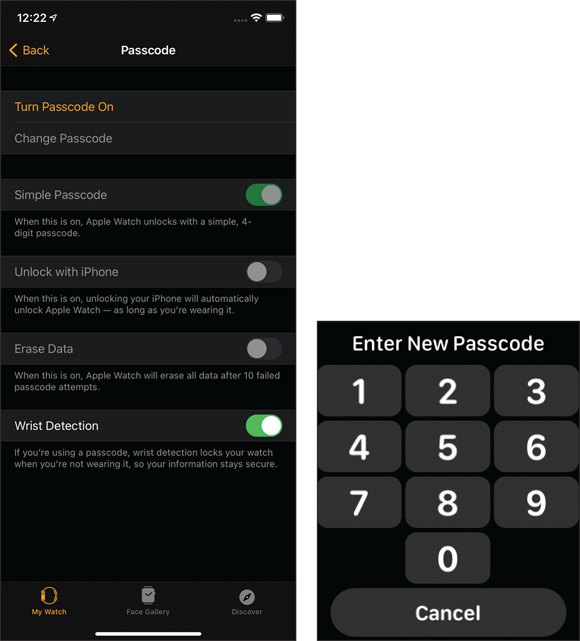
FIGURE 10-5: Use your iPhone to create your four-digit passcode for your Apple Watch (left). You are prompted to enter one on a virtual keyboard (right).
And as you might guess, those sensors on the back of the watch aren’t just used for your heartbeat; they know whenever the watch has been taken off. And you must once again type your secret passcode when you put the Apple Watch back on your wrist.
Clever, eh?
That way, if someone puts on your Apple Watch or tries to use it without slapping it on his or her wrist, your information is safe because the other person won’t know your passcode.
Looking at the Wallet App
 Just like the app on your iOS devices — iPhone, iPad, or iPod touch — Wallet is available on Apple Watch, and it also lets you store your airline boarding passes (with scannable QR code), movie and sports tickets, coupons, loyalty cards, and much more, as shown in Figure 10-6. Think of it as a handy digital version of your actual wallet (if you still use one).
Just like the app on your iOS devices — iPhone, iPad, or iPod touch — Wallet is available on Apple Watch, and it also lets you store your airline boarding passes (with scannable QR code), movie and sports tickets, coupons, loyalty cards, and much more, as shown in Figure 10-6. Think of it as a handy digital version of your actual wallet (if you still use one).
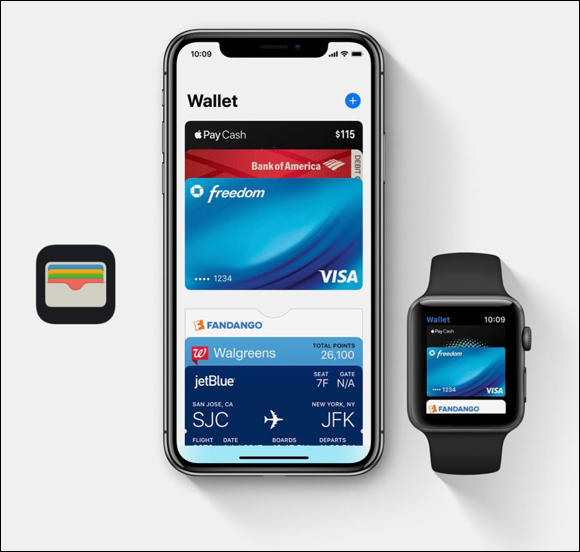
FIGURE 10-6: The Wallet app on Apple Watch and iPhone for retail purchases can also store plane tickets, loyalty cards, event passes, and even coffee (Starbucks)!
Other sections in this chapter talk about how Wallet can house your payment cards — credit or debit — for use with Apple Pay and how to change between cards if you like. In this section, I cover other things you can do with the Wallet app.
After all, accessing Wallet from your wrist is awesome. For example, you can use it to have an airline attendant scan a QR code on your wrist to board a plane while you’re negotiating an important deal on your iPhone. Plus, location and time services allow Wallet to notify you about relevant information just when you need it, such as gate changes at the airport.
When you download an app that supports Wallet, you have the option to add it to Wallet. Then, in your Wallet, you can flip through these apps, represented by virtual cards, with your fingertip to see each of their services and get them ready for when you need them. You can also be notified when you step inside a supported retailer or another location, or when information regarding a particular service updates, such as a cancelled concert.
How to get going?
Wallet is already preinstalled on all iPhones. If the app you download supports it, Wallet asks you if it can add that particular app to your Wallet. Examples of supported apps include United Airlines, Target, Ticketmaster, Fandango, Walgreens, and Starbucks, to name a few.
For example, to use the Starbucks app, follow these steps on your iPhone:
- Download the Starbucks app from the App Store.
-
Sign up for the Starbucks Rewards loyalty program or sign in if you’re already a member.
You’re prompted with this message: “Would you like to add your Starbucks card to your Wallet?”
-
Tap Continue to add Starbucks to Wallet.
This message appears: “Choose your favorite stores, and your Starbucks card will appear on your lock screen when you arrive.”
-
Let the phone’s GPS locate the nearest Starbucks, and then you can select a few as favorites.
When you’re done, you should see the Starbucks card pop up in your Wallet app — with a scannable QR code and cash balance of your account, as shown in Figure 10-7. Now hold out your Apple Watch to have the screen scanned by a barista at the cash register.
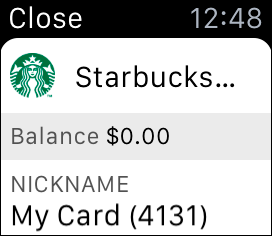
FIGURE 10-7: Arguably, Starbucks is one of the more popular Wallet-supported loyalty cards. This is what the Starbucks app looks like on your Apple Watch.
Adding passes to Wallet
You can add passes in many ways — as well as student ID cards and virtual car keys — to your Wallet app. Let us count the ways, beginning with adding it to your iPhone (which then syncs with Apple Watch):
- Find through the Wallet app. Open the Wallet app, tap Edit Passes, and tap Find Apps for Wallet.
- Scan a barcode or QR code. Open the Wallet, tap Edit Passes, tap Scan Code, and scan with your iPhone camera.
- Add through a notification. If you use with Apple Pay at a supported merchant and you get a notification, tap the Wallet notification to add the pass to Wallet.
For student ID cards, use your school's student account management app.
For car keys, use the app provided by your car's manufacturer, add keys from email, or use your car's information display (if your vehicle is supported).
Note: In some cases, you might need to tap Add to Apple Wallet, and then tap Add in the upper-right corner of the pass. Or you might see a pop-up notification with an Add button you can tap to add your pass to Wallet.
To add passes to Wallet in Apple Watch, you can
- Follow the instructions in the email sent by the pass issuer.
- Open the app from the issuer.
- Tap Add in a notification from the issuer.
To remove passes from Wallet, on your iPhone, open the Wallet app, and scroll down to tap Edit Passes. Tap the arrow button. Tap Delete. When you tap Delete, the pass is also removed from the Wallet on your Apple Watch.
Using passes on Apple Watch, including the Car Key feature
Now, whenever you’d like to call up your pass in Wallet, double-press the side button on Apple Watch and select what pass you’d like to use from the available cards. You can scroll up or down and select one, such as a Starbucks code, Student ID card, transit pass, and so on.
Let me share with you one of the coolest ways to use your Apple Watch: as a virtual car key!
That’s right, car keys have been around for about 100 years. But did you know you can now leave them at home and just use your Apple Watch or iPhone?
If your vehicle offers the option to control your vehicle with a digital car key, you can add this key to the Wallet app.
Then, when you want to get into your vehicle, place your Apple Watch or iPhone near the handle to unlock it, via NFC (near-field communication). Climb inside, place your iPhone in the car's key reader, or hold your Apple Watch near the reader, and then press the car's Start button to drive. See Figure 10-8.
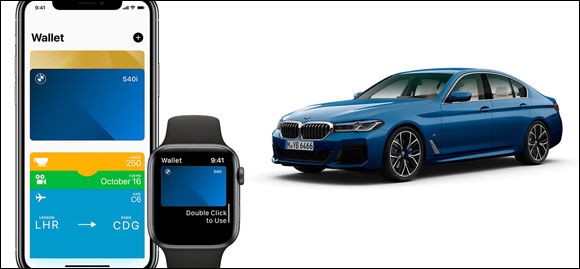
FIGURE 10-8: While it may sound like science-fiction, you can use your Apple Watch to unlock and drive your (supported) vehicle, such as this BMW. You can also share a virtual key with family and friends, too.
Cool, no? It gets better.
One of the best features of a digital key is the ability to share it. Through iMessage you can select a family member to grant them access — with restrictions if you want.
The future is here.
And yes, if you misplace your Apple Watch, no one can access the Wallet app unless it’s you (because of your passcode), but you can also turn off the Car Key remotely through iCloud.
Seeing notifications for passes on Apple Watch
To get notifications from Wallet, including when a pass changes — for example, the gate on your boarding pass is now at A47 instead of A49 — follow these steps:
- Open the Apple Watch app on your iPhone.
- Select the My Watch tab, and then scroll down and tap Wallet & Apple Pay.
- Tap Mirror My iPhone below notifications.
Using Apple Pay Cash on Apple Watch
So far, this chapter has discussed Apple Pay and how to use your Apple Watch or iPhone to make payments at retail locations or online. Did you know you can also send people money through your Apple device?
Called Apple Pay Cash, this easy-to-use technology is designed for person-to-person payments. It’s essentially a version of Apple Pay that lets you send or receive money right in the Messages app (discussed in Chapter 5), or by asking Siri.
You can use the cards you already have in Wallet to send money, split a bill at a restaurant, or chip in on a gift for a coworker. Figure 10-9 shows this wonder in action.
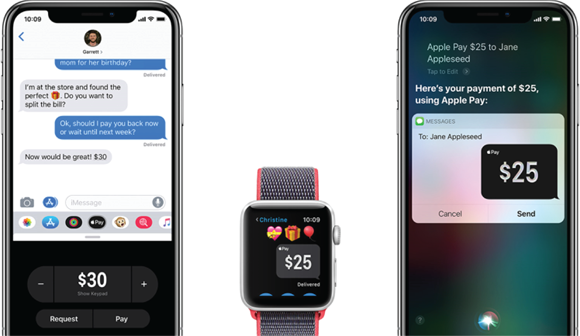
FIGURE 10-9: Available in the U.S. only, Apple Pay Cash lets you send or receive money via the Messages app.
Apple Pay Cash requirements
Here’s what you need to get going:
- United States residency. You also need to be 18 years of age or older.
- A compatible device with iOS 11.2 and later or watchOS 4.2 and later.
- Two-factor authentication for your Apple ID, which requires both a password and one-time code sent to your iPhone to confirm it’s really you.
- Connection (sign in) to iCloud with your Apple ID on any device that you want to use to send or receive money.
- An eligible credit or debit card in Wallet (see earlier in this chapter on adding cards).
- Agreement with the Terms and Conditions, something required the first time that you try to send or receive money.
- Verification of your identity (you may be asked this).
Now, right from your iPhone, iPad, or Apple Watch, friends can securely send and receive money. Just be aware that Apple Cash is for personal use only and not for any business-related activities, such as paying business expenses or paying employees, per Apple.
Setting up Apple Pay Cash in Wallet
If you’re setting up Apple Pay Cash for the very first time, you need to use any supported device that allows you to sign in to iCloud with your Apple ID. To do so:
- Tap Settings ⇒ Wallet & Apple Pay.
- Tap the Apple Pay Cash card, and then follow the onscreen instructions.
- To enable Apple Pay Cash on Apple Watch, open the Apple Watch app on iPhone, and then tap My Watch ⇒ Wallet & Apple Pay (see Figure 10-10).
- Tap the Apple Pay Cash toggle so it turns green and says “Enable sending and receiving money in Message on Apple Watch.”
Apple confirms there is no fee to use Apple Pay Cash with a debit card. If you send money using a credit card, though, there’s a standard 3 percent credit card fee on the amount.
If someone sends you money via Apple Cash, it’s automatically kept on your Apple Pay Cash card. You see your new Apple Pay Cash card in your Wallet, and you can use the money to send to someone; to make purchases using Apple Pay in stores, within apps, and on the web; or to transfer it from Apple Pay Cash to your bank account.

FIGURE 10-10: A look at setting up Apple Pay Cash on iPhone (left) and enabling Apple Watch support (right).
Using Apple Watch to send cash to friends
Once you’re all set up, it’s super easy to send cash to someone through your Apple Watch (see Figure 10-11)!
-
Open the Messages app (see Chapter 5 for more on messaging).
You may need to press Digital Crown to see all your apps.
- Start a new conversation or tap to open an existing one.
- Scroll down, and then tap Apple Pay.
-
Choose an amount by turning the Digital Crown.
To enter an exact amount, tap the dollar amount, tap after the decimal, then turn the Digital Crown.
-
Tap Pay.
To review the payment information or cancel, scroll down. Your money in Apple Pay Cash will be used to pay first.
- To send the payment, double-press the side button.
-
To cancel a payment after sending, tap the payment to see its details, and then check the Status field and tap Cancel Payment.
 You can use Siri to send money! Say something like, “Apple Pay 50 dollars to Steve for movie tickets” or “Send 25 dollars to Susan.”
You can use Siri to send money! Say something like, “Apple Pay 50 dollars to Steve for movie tickets” or “Send 25 dollars to Susan.”
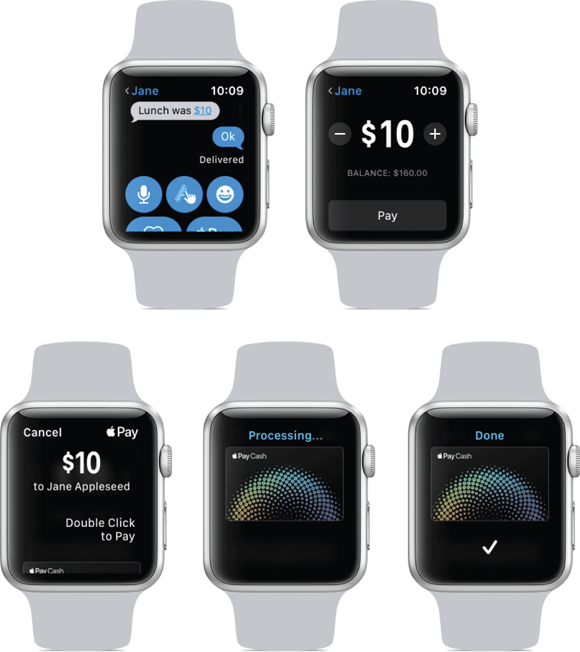
FIGURE 10-11: Sending money to someone through Apple Watch is super easy, fast, and secure.
Using Apple Watch for Other Deals and Rewards
Besides using Apple Watch to make purchases and offer support for loyalty cards, you can also use it in ways that serve up a richer shopping experience. Folding in other technologies, you can utilize Apple Watch to customize the store experience to suit individual preferences. For example, stores equipped with Apple’s iBeacon location-based technology (developer.apple.com/ibeacon) can identify you from your Apple Watch (and/or nearby iPhone). This means the technology welcomes you, rewards you with points for stepping into a store, notifies you about deals, and gives personalized suggestions based on previous interests.
Of course, these are things you have to opt into. That is, you must first give the store permission in its downloadable app.
Imagine stepping into a retailer and seeing what you need to know on the Apple Watch screen. It’s still early days, but the technology is there. Just ask Cyriac Roeding, the celebrated entrepreneur, investor, and cofounder/CEO of Shopkick, an app that helps you find deals and earn rewards.
“While it’s still a little early, smartwatches like Apple Watch are a next, natural step in the evolution of the shopping experience,” believes Roeding, whose Shopkick app is the most widely used shopping app at retail stores in the United States, according to Nielsen. As of April 2017, Shopkick said it had powered more than “200 million store visits, over 270 million product scans in aisle, and over $2.5 billion in total sales from brand and retail partners” (according to Wikipedia). Roeding says Shopkick’s Apple Watch app offers much of the same experience as the smartphone app “but without you having to take out your phone.” When you walk into one of the many stores with Shopkick’s shopBeacon transmitters — built upon Apple’s location-based iBeacon technology — you’re welcomed by name, rewarded with redeemable kicks (points) for walking in the door, and notified of curated deals based on your previous shopping habits. See Figure 10-12 for an example of Shopkick’s technology (courtesy of Shopkick).
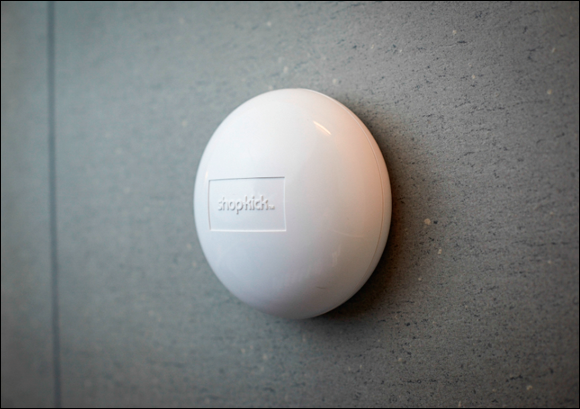
FIGURE 10-12: A look at Shopkick’s shopBeacon transmitter on the wall of a retailer.
shopBeacon’s location technology, which uses ultrasound and Bluetooth low energy (BLE), does not collect any information about you, assures Roeding, because it only sends information instead of collecting data.

 Whenever you use your credit or debit card at a retailer, your card number and identity, including your name, is visible to the retailer. This can cause privacy and security risks. However, Apple Pay uses a unique Device Account Number (DAN) for each transaction. This DAN is generated, encrypted (securely blocked from outsiders), and then stored in the Secure Element — a dedicated chip inside the iPhone, iPad, and Apple Watch. Apple says these numbers are never stored on Apple servers. The DAN and a dynamically generated security code are used to process your payment when purchasing something; therefore, your actual credit or debit card number is never shared by Apple with the retailer.
Whenever you use your credit or debit card at a retailer, your card number and identity, including your name, is visible to the retailer. This can cause privacy and security risks. However, Apple Pay uses a unique Device Account Number (DAN) for each transaction. This DAN is generated, encrypted (securely blocked from outsiders), and then stored in the Secure Element — a dedicated chip inside the iPhone, iPad, and Apple Watch. Apple says these numbers are never stored on Apple servers. The DAN and a dynamically generated security code are used to process your payment when purchasing something; therefore, your actual credit or debit card number is never shared by Apple with the retailer. Apple Watch works with any iPhone 5 or newer; iPad Pro, iPad Air, iPad, and iPad mini models with Touch ID or Face ID; and Mac models with Touch ID or any models introduced in 2012 or later with an Apple Pay-enabled iPhone or Apple Watch nearby. You can use Apple Pay with a compatible Mac for payments on the web (with the Safari web browser).
Apple Watch works with any iPhone 5 or newer; iPad Pro, iPad Air, iPad, and iPad mini models with Touch ID or Face ID; and Mac models with Touch ID or any models introduced in 2012 or later with an Apple Pay-enabled iPhone or Apple Watch nearby. You can use Apple Pay with a compatible Mac for payments on the web (with the Safari web browser).